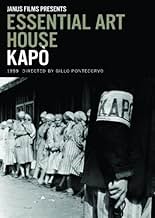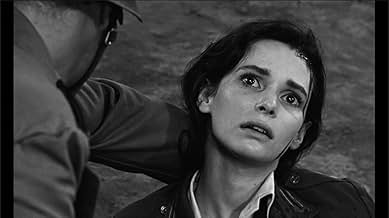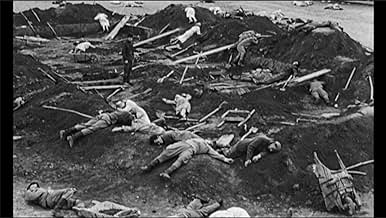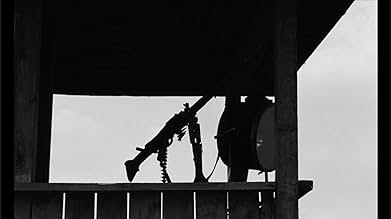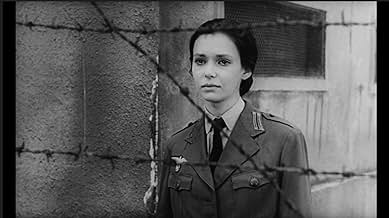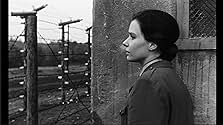Kapò
- 1960
- 1h 57m
IMDb RATING
7.6/10
2.8K
YOUR RATING
A young Jewish girl leads an escape attempt from a concentration camp.A young Jewish girl leads an escape attempt from a concentration camp.A young Jewish girl leads an escape attempt from a concentration camp.
- Nominated for 1 Oscar
- 3 wins & 4 nominations total
Semka Sokolovic-Bertok
- Une detenuta
- (as Semca Sokolovic)
Dirjana Dojic
- Ninette
- (as Dirjana Dojc)
Graziella Durano
- Une detenuta
- (uncredited)
Sima Janicijevic
- Il medico di Auschwitz
- (uncredited)
Rastislav Jovic
- Yanko Milovich
- (uncredited)
Dusan Perkovic
- Il commandante tedesco
- (uncredited)
Featured reviews
If somebody would like to see what was a nazi prison, one has to see this movies. It showed with realism the nature of cruelty by nazis and the ways they used some of their prisoners to watch the movement of the rest and to combat effectively any possible plot against them. Pontecorvo is a director with a few films, but all of them always show real facts of the history, and this film is not an exception
Edith is a Jewish teen whose family is among those loaded onto boxcars and shipped to Auschwitz. This is a story of brutality and Susan Strasberg ("Picnic") plays the central character who struggles to survive the Nazi holocaust machine.
Shot in black and white, of course, the film provides a stark and nearly unrelenting look at the depravity, deprivations, and degradations found in concentration camps. Strasberg is strong in her role, embodying the chameleon-like ability to change that gives her character a chance to survive, though survival has its price.
The action feels real, the locations feel real, and real emotions are evoked by this ambitious attempt to delve into the real human costs of barbarism---the loss of principles, the corruption of dignity, and the subtle shadings of resistance.
The Italian producers of this film pursued Strasberg for this role, somehow knowing that she had the depth within her to bring Edith to life on the screen. Her father, Lee, recommended she accept the role. Luckily, she did.
Shot in black and white, of course, the film provides a stark and nearly unrelenting look at the depravity, deprivations, and degradations found in concentration camps. Strasberg is strong in her role, embodying the chameleon-like ability to change that gives her character a chance to survive, though survival has its price.
The action feels real, the locations feel real, and real emotions are evoked by this ambitious attempt to delve into the real human costs of barbarism---the loss of principles, the corruption of dignity, and the subtle shadings of resistance.
The Italian producers of this film pursued Strasberg for this role, somehow knowing that she had the depth within her to bring Edith to life on the screen. Her father, Lee, recommended she accept the role. Luckily, she did.
I was not previously aware of this gem. I found it on TCM after it had already been on for about 10 minutes. I kept thinking that the lead actress looked just like SUSAN STRASBERG & for good reason. It was. The fact that it was foreign with sub-titles threw me initially. Very realistic, almost raw, which was surprising considering that this movie was made in 1959.
STRASBERG as 'Nicole' works her way up through a concentration camp to become the woman in charge of her fellow prisoners. Strong language, violent situations, but this is a story about WWII, not the 'Enchanted Forest'. Good storyline, good direction, & a terrific performance by SUSAN STRASBERG that was all the more admirable when you realize that she was all of 20,21 when she made this.
STRASBERG as 'Nicole' works her way up through a concentration camp to become the woman in charge of her fellow prisoners. Strong language, violent situations, but this is a story about WWII, not the 'Enchanted Forest'. Good storyline, good direction, & a terrific performance by SUSAN STRASBERG that was all the more admirable when you realize that she was all of 20,21 when she made this.
As with my recent viewing of Bernhard Wicki's THE BRIDGE (1959), I was introduced to the film under review via a still from it adorning the large and lavishly-illustrated "War Movies" tome I used to pore over as a kid; actually, apart from a recent Italian TV screening, I only recall a solitary broadcast of it back then one Friday night – this was also true of Pontecorvo's best-known work, THE BATTLE OF ALGIERS (1965), which I did catch much later on TV and subsequently on the big-screen in London – but, given the adult subject matter, I passed on it. Having now finally caught up with the movie (another title to make the "Wonders In The Dark" all-time top 3.000 list) after all these years, as part of my ongoing Oscar marathon, I must say that it is one of the most miserable viewing experiences I have ever had!
The fall of the Third Reich in mid-1945 brought an unsuspecting world face to face with the shocking truth of Nazi concentration camps; this led to the infamous Nuremberg trials of 1947 and, perhaps inevitably, cinematic depictions of this horrific genocide. The most celebrated of these are Alain Resnais's harrowing short NIGHT AND FOG (1955; detailing the findings at the Auschwitz camp) and Steven Spielberg's Oscar-laden SCHINDLER'S LIST (1993; dealing with a real-life German industrialist who hid thousands of persecuted Jews among his factory employees). KAPO' – being the name given by the captors to the favoured one within each barracks whom they have selected to be its warden – might well be the very first feature-length movie on this theme; while clearly evoking the "Neorealist" school in its unremitting bleakness and dispassionate viewpoint, what is most surprising – in hindsight – is that, in many ways, this also anticipates the reprehensible "Women In Prison" and Nazisploitation subgenres in Euro-Cult fare of the late 1960s and 1970s!
In a somewhat sensationalistic touch, the protagonist who becomes the titular Nazi lackey is a Jew passed off by the camp medic as a French girl after having witnessed her parents' oblivious march towards the gas chamber. She is played by American Susan Strasberg: though we are asked to believe that she is a virginal 14 year-old who soon becomes the young officers' favourite 'lay' (among them Gianni Garko), the actress is effective in delineating the character's trajectory from doe-eyed innocent to callous parasite (even if it seems this is primarily done in order to appease her personal hunger) to hopeless romantic (she becomes enamoured of rebellious Russian POW Laurent Terzieff) to resigned martyr (the heroine's elite position in the camp makes her the ideal, albeit endangered, candidate to switch off the electrically-charged barbed-wire fence that would precipitate a mass escape attempt). Interestingly enough, Strasberg had just been passed over in recreating her Broadway role for George Stevens' screen rendition of THE DIARY OF ANNE FRANK (1959).
As expected, the supporting female cast is carefully chosen so as to encompass a wide variety of types among both victims and collaborationists: most notable, however, are Emmanuelle Riva (as the one who initially takes Strasberg under her wing but is then shunned by the new Kapo' and ends up committing suicide via electrocution) and Didi Perego (a Silver Ribbon award winner for Best Supporting Actress as the statuesque leader of the inmates whose outspokenness eventually leads to her being gunned down in cold blood). Pontecorvo (whom I saw at the 2004 Venice Film Festival during a screening of the Michelangelo Antonioni/Wong Kar-Wai/Steven Soderbergh-directed anthology EROS and has since passed away) did not have a prolific career, but his place in the annals of World Cinema is assured on the strength of THE BATTLE OF ALGIERS alone; incidentally, he is also credited with collaborating on Carlo Rustichelli's brooding score. As for co-director Montaldo (whose contribution, whatever it entailed, has never been given its due), he was invited over here a couple of years ago to introduce a number of his films screened as part of some Italian festival – but these were oddly scheduled during the mornings, thus making it impossible for me to attend!
The fall of the Third Reich in mid-1945 brought an unsuspecting world face to face with the shocking truth of Nazi concentration camps; this led to the infamous Nuremberg trials of 1947 and, perhaps inevitably, cinematic depictions of this horrific genocide. The most celebrated of these are Alain Resnais's harrowing short NIGHT AND FOG (1955; detailing the findings at the Auschwitz camp) and Steven Spielberg's Oscar-laden SCHINDLER'S LIST (1993; dealing with a real-life German industrialist who hid thousands of persecuted Jews among his factory employees). KAPO' – being the name given by the captors to the favoured one within each barracks whom they have selected to be its warden – might well be the very first feature-length movie on this theme; while clearly evoking the "Neorealist" school in its unremitting bleakness and dispassionate viewpoint, what is most surprising – in hindsight – is that, in many ways, this also anticipates the reprehensible "Women In Prison" and Nazisploitation subgenres in Euro-Cult fare of the late 1960s and 1970s!
In a somewhat sensationalistic touch, the protagonist who becomes the titular Nazi lackey is a Jew passed off by the camp medic as a French girl after having witnessed her parents' oblivious march towards the gas chamber. She is played by American Susan Strasberg: though we are asked to believe that she is a virginal 14 year-old who soon becomes the young officers' favourite 'lay' (among them Gianni Garko), the actress is effective in delineating the character's trajectory from doe-eyed innocent to callous parasite (even if it seems this is primarily done in order to appease her personal hunger) to hopeless romantic (she becomes enamoured of rebellious Russian POW Laurent Terzieff) to resigned martyr (the heroine's elite position in the camp makes her the ideal, albeit endangered, candidate to switch off the electrically-charged barbed-wire fence that would precipitate a mass escape attempt). Interestingly enough, Strasberg had just been passed over in recreating her Broadway role for George Stevens' screen rendition of THE DIARY OF ANNE FRANK (1959).
As expected, the supporting female cast is carefully chosen so as to encompass a wide variety of types among both victims and collaborationists: most notable, however, are Emmanuelle Riva (as the one who initially takes Strasberg under her wing but is then shunned by the new Kapo' and ends up committing suicide via electrocution) and Didi Perego (a Silver Ribbon award winner for Best Supporting Actress as the statuesque leader of the inmates whose outspokenness eventually leads to her being gunned down in cold blood). Pontecorvo (whom I saw at the 2004 Venice Film Festival during a screening of the Michelangelo Antonioni/Wong Kar-Wai/Steven Soderbergh-directed anthology EROS and has since passed away) did not have a prolific career, but his place in the annals of World Cinema is assured on the strength of THE BATTLE OF ALGIERS alone; incidentally, he is also credited with collaborating on Carlo Rustichelli's brooding score. As for co-director Montaldo (whose contribution, whatever it entailed, has never been given its due), he was invited over here a couple of years ago to introduce a number of his films screened as part of some Italian festival – but these were oddly scheduled during the mornings, thus making it impossible for me to attend!
A teen Jewish girl and her family are imprisoned in a concentration camp . There, the 14-years-old girl played by Susan Strasberg finds a harsh reality and changes identities with the help of the camp medic and rises to the position of Kapo. This is a good movie about the brutal existence at concentration camps and subsequent breakout from horrible place. This excellent movie deals about extermination center, abuse of camp guards or Kapos who enjoy their power, prisoners committing suicide and the subsequent getaway led by Laurent Terzieff and Russian prisoners . We see the horrors,murders,massacres against the prisoners and Nazis personify evil . Thus , when the incoming transports ,mostly Jews, SS soldiers made instant decisions,those who were fit to labors were sent into the camp, others including the children ,were dispatched immediately to the gas chambers.Finally the inmates broke out in a desperate riot that I believe it can be the concentration camp of Sorbibor, only in which Russian prisoners achieved to escape . The picture reflects perfectly the atrocities as a by-product of sheer Nazi evil . The flick is powered by splendid performances , as Susan Strasberg, -daughter of Lee Strasberg, creator of Actors studio- as suffering starring and Laurent Terzieff is watchable as obstinate Russian soldier wishing freedom. Appears as secondary actor playing a Nazi soldier Gianni Garco or John Garco, future Spaghetti Western hero named Sartana . Shot in magnificent black and white by Sekulovic and Carlo De Palma , Woody Allen's usual cameraman . Sensitive and atmospheric score by Carlo Rustichelli. The film achieved an Academy Award nominee for Best Foreign movie but lost to the ¨Virgin Spring ¨. This extraordinary and unknown film by one of the pioneers of political film , he always interesting director Gillo Pontecorvo. It was one of the first films about the theme of Jewish holocaust and one of the more realistic in its recreation . Gillo subsequently will directed ¨Battle of Argel¨ and ¨Queimada¨.
The picture is based on real events and survivor's memories,these are the following : The large death camps were transformed into extermination centers to implement the policy of genocide thought at the Wannsee Conference (1942). There was some minor industrial activity linked to the war effort but the main work was the execution of inmates (as happen with the starring's family) . Victims (as Susan Strasberg and her parents) were brought to the camp in unventilated transports, and all but a handful were gassed after arrival,the gas chambers could accommodate hundred prisoners at one time using Zyclon B which was a crystallized prussic acid which dropped into death chamber ,most of their corpses were burned in open pits (as occurs at the ending of the movie when is opened a large hole to bury unfortunates).
The picture is based on real events and survivor's memories,these are the following : The large death camps were transformed into extermination centers to implement the policy of genocide thought at the Wannsee Conference (1942). There was some minor industrial activity linked to the war effort but the main work was the execution of inmates (as happen with the starring's family) . Victims (as Susan Strasberg and her parents) were brought to the camp in unventilated transports, and all but a handful were gassed after arrival,the gas chambers could accommodate hundred prisoners at one time using Zyclon B which was a crystallized prussic acid which dropped into death chamber ,most of their corpses were burned in open pits (as occurs at the ending of the movie when is opened a large hole to bury unfortunates).
Did you know
- TriviaThe producers imposed a romance line in the story and also another ending, different from the one Pontecorvo, the director, wished to shoot.
- GoofsIn the opening scene, Edith walks past some shops on her way back home. One of the shops look like it belongs to the booming 1950s than the more austere WWII period. There is a toy car or baby push car in the store window that shows the typical car design of the 1950s.
- Quotes
Edith, alias Nicole Niepas: [to Sasha] Your mother won't like me, I'm not a good girl, and my name's not Nicole, I'm a Jew.
- ConnectionsFeatured in Pontecorvo: The Dictatorship of Truth (1992)
- How long is Kapo?Powered by Alexa
Details
- Runtime1 hour 57 minutes
- Color
- Sound mix
- Aspect ratio
- 1.66 : 1
Contribute to this page
Suggest an edit or add missing content



